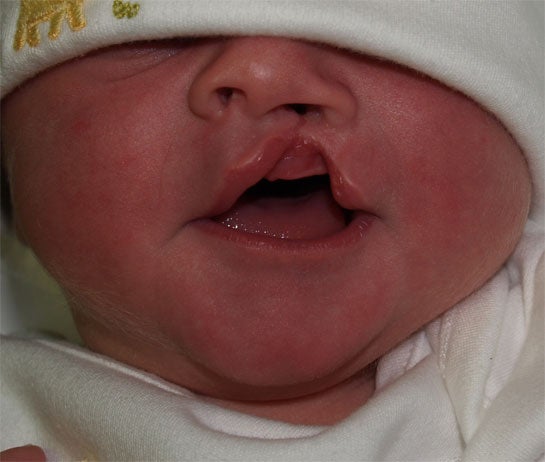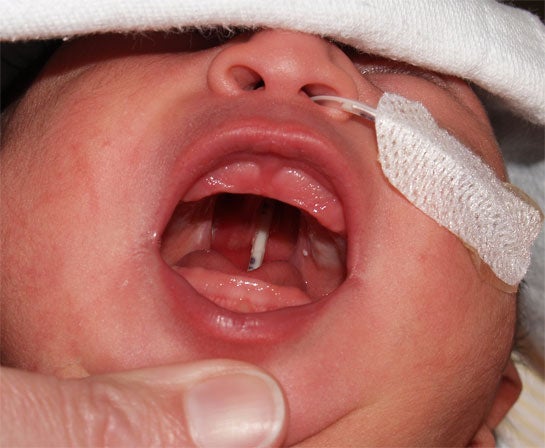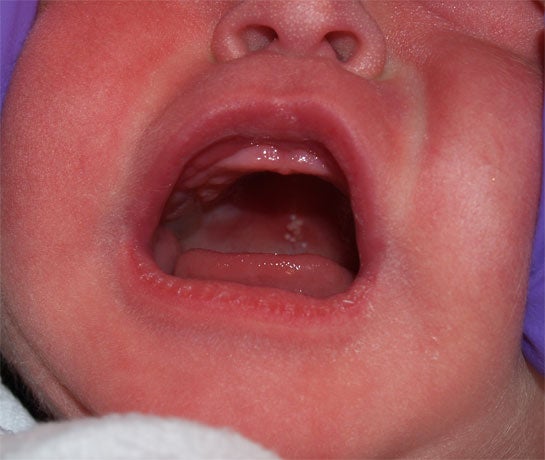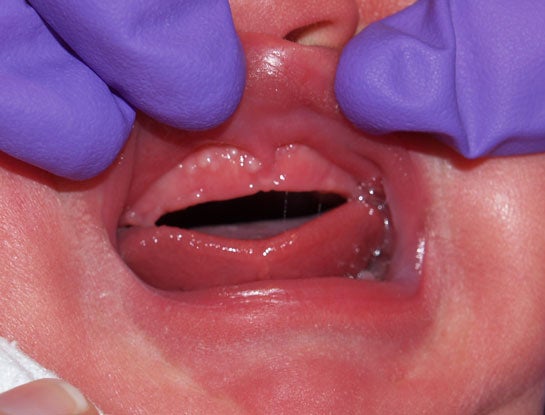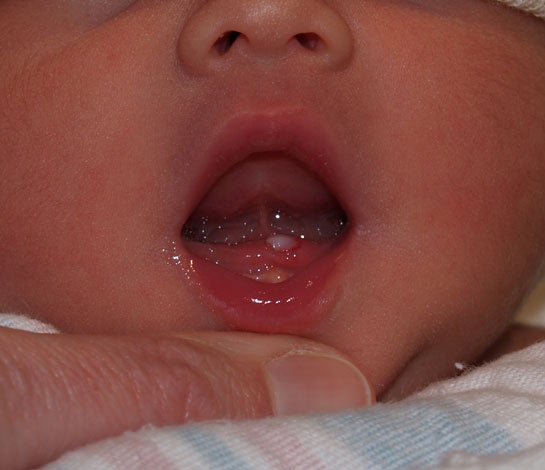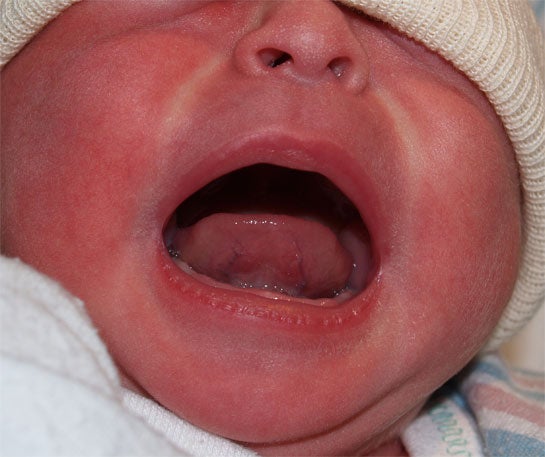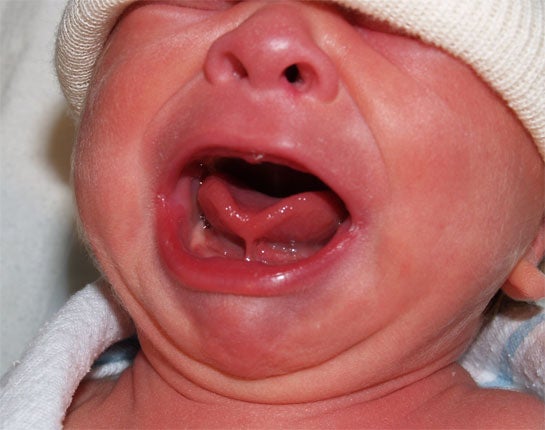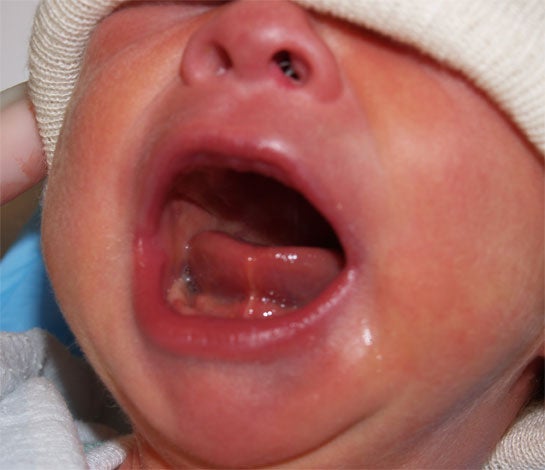FACE: EYES, EARS, NOSE, AND MOUTH ASSESSMENT
Eyes
Most parents who see their infant for the first time focus on the head and the face especially the eyes as they are the most dominant facial feature of the neonate. Many of the worrisome abnormalities are transient phenomena, related to birth or immaturity of the neurological system.
- Iris color of the eyes is usually grayish-blue in caucasian infants and grayish-brown in infants of color. The final color of the individual newborn's eyes occurs as pigment is gradually deposited over the next 6 to 12 months.
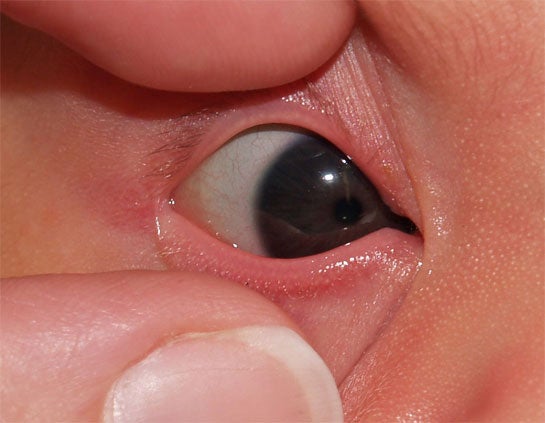
Normal Eye
Picture used with permission Dr. Janelle Aby, Stanford Medical School, Palo Alto, CA
- Tears are not usually produced until one-to-three months of age.
- The sclera usually have a bluish tint. Yellow sclera can indicate jaundice.
- Conjunctival hemorrhage can occur with traumatic birth. This resolves over the first week of birth.
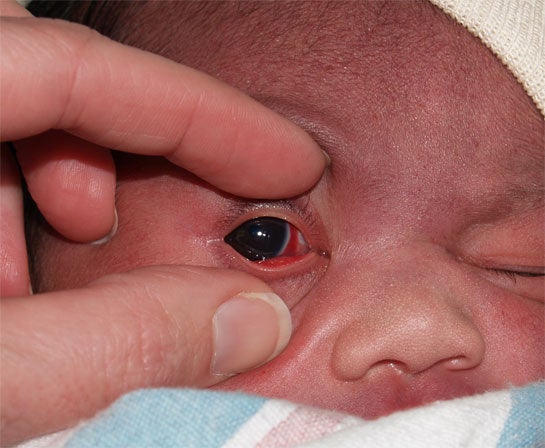
Conjunctival Hemorrhage
Picture used with permission Dr. Janelle Aby, Stanford Medical School, Palo Alto, CA
- Although the eyes appear mature, the macula, which provides central vision begins to differentiate shapes and color during the first month, but is not fully developed until eight months of age.
- Infants can have pseudostrabismus or
 nystagmus
nystagmus . This recedes by the third or fourth month as the orbital muscles mature.
. This recedes by the third or fourth month as the orbital muscles mature.
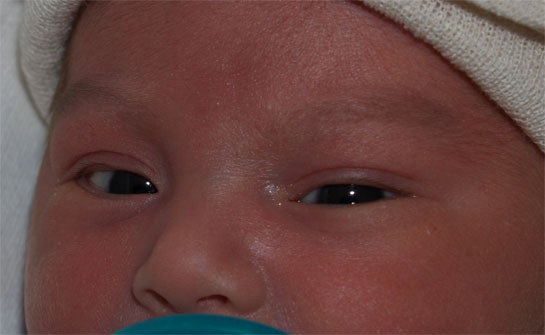
Pseudostrabismus
Pictures used with permission Dr. Janelle Aby, Stanford Medical School, Palo Alto, CA
- The eyelids may be swollen and reddened from birth or from the erythromycin eye ointment
 .
. - Petechiae or telangiectasias, also known as "storks bites"
 may occur on the eyelids or forehead and nape of neck. They are classified as vascular nevi and usually disappear by 12 months.
may occur on the eyelids or forehead and nape of neck. They are classified as vascular nevi and usually disappear by 12 months.
An attempt to open the eyelids usually meets with resistance, especially if the infant is crying or there is a bright light. To open the eyes spontaneously, hold the infant upright and gradually rotate him. If this does not work, hold the head steady with one hand while you use the "pointer finger and thumb" of the other hand to gently open the eye and look at the iris and sclera. (See picture of "Normal eye" above). Nurses do not assess the red reflex or pupillary dilation of the newborn eye.
Ears
Assess the position of each ear by drawing an invisible line across the inner and outer canthus of the eye to the insertion of the ear, not the height of the pinna.
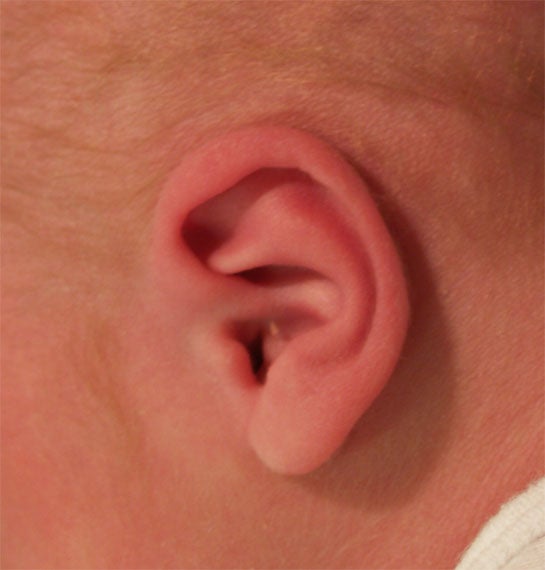
Normal Ear
Picture used with permission Dr. Janelle Aby, Stanford Medical School, Palo Alto, CA
- Low-set ears can be associated with abnormalities of the internal organs (especially kidneys)
 , chromosomal disorders or mental retardation.
, chromosomal disorders or mental retardation.
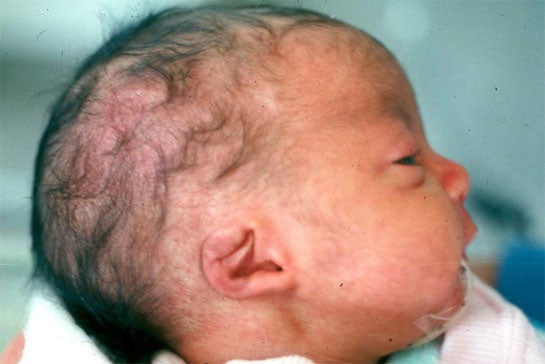
Low Set Ears in Trisomy 18
Picture used with permission Dr. David Clark Stanford Medical Center, Palo Alto, CA
- Assess for size (large, small) and stiffness of the ear lobe. In mature infants, when the ear lobe is lightly bent forward and let go, it will quickly return to the previous shape. Premature infants often have a lack of cartilage, so their ears may be less resilient with this assessment.
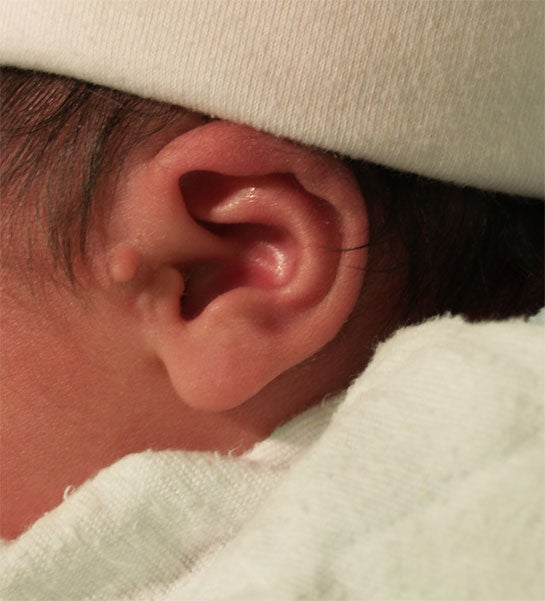
Preauricular Ear Tag
Picture used with permission Dr. Janelle Aby, Stanford Medical School, Palo Alto, CA
- A preauricular ear tag is an extra piece of material on outside of ear. May be removed or not. Assess for renal abnormalities as the ears and kidneys form at the same time embryologically.
- Assess for response to sound while in the quiet alert state. Most hospitals complete a hearing test on the infant prior to discharge from the hospital. If the infant does not pass the test, a referral is made.
Nose
Observe for flaring (enlargement of the nostrils), a sign of respiratory distress. Newborns may do this occasionally. They may also do this more frequently after birth. If flaring occurs with an elevated respiratory rate, retractions and/or grunting, notify the physician.
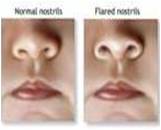
Left:Normal nares Right:Flared nostrils
Malformations of the nose or copious drainage may occur with choanal atresia or congential syphillis.
or congential syphillis.
Mouth
Assess the outside and inside of the mouth. The color of the lips, gums and tongue should be red.
- Inspect the lips for abnormalities (cleft lip,circumoral palor or cyanosis,or asymmetrical movement of the lips).
- Don a glove to palpate the upper part of the mouth for an intact soft and hard palate. A cleft palate may occur with a cleft lip or separately. Both affect feeding efficiency by breast or bottle and need surgical repair.
|
|
|
|
Cleft Lip |
Cleft Palate (feeding tube is visible where palate is absent) |
Pictures used with permission Dr. Janelle Aby, Stanford Medical School, Palo Alto, CA
- Check the strength of the infant's suck reflex.
- Check the gums or palate for nodules that look like grains of rice. These are called Epstein Pearls or Bohn's Nodules and are hereditary. The infant may also have teeth. These are normal variations that are not treated.
|
|
|
|
|
Epstein Pearls |
Bohn's Nodules |
NatalTooth |
Pictures used with permission Dr. Janelle Aby, Stanford Medical School, Palo Alto, CA
- Assess the tongue for attachment, mobility and size. A tongue which has a short frenulum may cause the infant to have difficulty latching and sucking on the breast. (See article: http://pediatrics.aappublications.org/cgi/content/full/110/5/e63). Sometimes the frenulum stretches. Sometimes it needs to be clipped by a pediatrician or a surgeon to increase movement.
|
|
|
|
|
Normal tongue. |
Short frenulum or ankyloglossia. |
tongue after clipping short frenulum |
Pictures used with permission Dr. Janelle Aby, Stanford Medical School, Palo Alto, CA
| Click 'Show' to see the hidden portion. | ||
| Answers | ||
